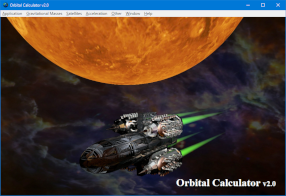Table of Contents
I'm a novelist and have an interest in space science and physics. I've been a programmer for more than 40 years and I like reviewing new and up-and-coming authors. I have become a committed member of the OpenSimulator community.
Please consider registering (see top of page) to help support this site. Your personal data isn't shared with anyone, but it makes me feel good.
International Space Station
This page has a portal through which you can view the current location of the International Space Station, updating in real-time. The tracker itself comes from the European Space Agency (ESA).
There is also a handy link to get email notifications direct from NASA when the ISS is visible in your night sky.
Automatic Weather Updates
The Mars Weather page is now 99.99% automatic, with rebuilds regularly throughout the day. The 0.001% that's not automated? Once a week I have to update the image that shows the relative positions of the inner planets. I think I can manage that 
Incidentally, the automation software fully rebuilds the page from the ground up, and it seems to have fixed my inability to edit the page through the wiki front-end. Maybe I didn't close off a tag or something and it upset the wiki (but not enough to stop it from generating and displaying the page).
Incidentally, the weather data is stored in a couple of sqlite3 files, so if anybody wants copies, just ask in the comments below.
Adjustment to Mars Clocks
 The Martian clocks (keeping Martian time) on the Mars Weather page also display the Ls (pron. ell sub ess) - a way of describing where the planet is in its orbit1), and the displacement of the sun in the sky at midday. I noticed the value for this was out by some distance, and after pondering the problem (and the code) for a while, the penny dropped.
The Martian clocks (keeping Martian time) on the Mars Weather page also display the Ls (pron. ell sub ess) - a way of describing where the planet is in its orbit1), and the displacement of the sun in the sky at midday. I noticed the value for this was out by some distance, and after pondering the problem (and the code) for a while, the penny dropped.
Unfortunately, the code was still generating a value that was out by 1/100th of a degree, which isn't much but it bothered me. It turned out to be due to a rounding issue, so I fixed that. Ls is now displayed to five decimal places. This value matches that generated by Mar24, a program available from the Goddard Institute for Space Studies, a branch of NASA.
Orbital Calculator v2.0.6 Released
 Four major new functions for acceleration and gravity and a few tweaks under the hood. New functions include: Constant Velocity, Free-Fall, N-Body Centre of Gravity (in 3D space) and Distance/Speed/Time.
Four major new functions for acceleration and gravity and a few tweaks under the hood. New functions include: Constant Velocity, Free-Fall, N-Body Centre of Gravity (in 3D space) and Distance/Speed/Time.
These powerful functions allow you to calculate speed as a constant, as constant acceleration or as increasing acceleration, as well as determine the common centre of gravity of any number of astronomical or artificial space-born objects. Any number? Well, within limits, but they are large limits. A couple of potential bugs have been squished and I consumed vast amounts of coffee. Anything else you need to know? Oh yes, the details. Read on…
Oh, The Facts!
 There was a litany that writers used to be told, but is rarely heard these days. If you've been a writer for more than ten years you will probably recall it: “Stick to the facts!”. Does that mean your story ends up a dry, soulless, sequential list of equally dry, soulless facts? Of course not.
There was a litany that writers used to be told, but is rarely heard these days. If you've been a writer for more than ten years you will probably recall it: “Stick to the facts!”. Does that mean your story ends up a dry, soulless, sequential list of equally dry, soulless facts? Of course not.
Sure, we want to know that Jack went up the hill. We want to know he did so to fetch a pail of water. We also want to hear that he fell, and that Jill patched him up with (of all things) vinegar and brown paper. Those are the bare bones facts, and they about as full of life as a sterile Petri dish.
We also want to know why Jack went up the hill - to fetch the purest snow to make tea for his dying grandmother. We want to know that he put a telescope by her deathbed so she could monitor his progress. We want to know that the 'hill' was the Eiger, and that by dint of the location of the grandmother's bed, he has to climb the north face, else she won't be able to watch him. Knowing as we do that he falls, there are stakes, challenges, excitement and drama.
<< Newer entries | Older entries >>

